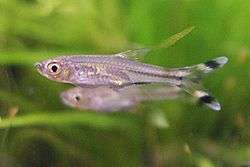Scissortail rasbora
| Scissortail rasbora | |
|---|---|
 | |
| Rasbora trilineata | |
| Scientific classification | |
| Kingdom: | Animalia |
| Phylum: | Chordata |
| Class: | Actinopterygii |
| Order: | Cypriniformes |
| Family: | Cyprinidae |
| Genus: | Rasbora |
| Species: | R. caudimaculata R. spilocerca |
| Binomial name | |
| Rasbora caudimaculata Volz, 1903 Rasbora spilocerca | |
The scissortail rasbora is the common name for a number of species freshwater aquarium fish that belongs to the rasbora family. The scissor-like movement of their tail fins as they swim is where their name is derived from. They are easy to manage, and require a tank 20 gallons or more in size. Scissortails can live for more than three years up to as long as 10 years.They are omnivores, but they love brine shrimp, frozen blood worms, mosquito larvae, and any other normal fish food.
Scientific Name : Rasbora trilineata
Common Names : Three lined Rasbora, Black Scissor Tail
Care Level : Fairly easy, good for freshwater fish beginner
Size : 5 inches (13 cm)
pH : 6 - 8
Temperature : 72°F - 79°F (22°C - 26°C)
Water Hardness : 5° to 15° dH,
Life Span : 3 - 5 years, sometimes longer
Origin / Habitat : Found in slow moving rivers and streams of Asia and Sumatra, Borneo
Temperament / Behavior : This rasbora is very peaceful and should do well in a community type setting. They do enjoy schooling, so groups of 5 or more work well. Scissortails can be nervous when they are disturbed, so aggressive barbs should never be introduced into their aquarium.
Breeding / Mating / Reproduction : Can be difficult since they are supposed to hide their eggs under a rock or similar item in the tank and will leave them unprotected. Low light tanks with small drops in pH have been reported to induce spawning behavior.
Tank Size : 20 gallon or larger.
Compatible Tank Mates : Peaceful tetras and other rasboras, smaller bottom dwelling species such as the Corydoras Catfish.
Fish Disease : Freshwater Fish Disease - Diagnose, Symptoms and Treatment
Diet / Fish Food : Omnivore, they will eat many fish foods including flakes, freeze dried and live foods. As with many fish, try to vary their diet for optimum health and colors. They eat insects in the wild but this can difficult to provide in the home aquarium.
Tank Region : Can range from the middle to the top, but mostly on the top of the tank.
Gender : Difficult to determine, but the female may be more round in shape.
Similar Species : Cyprinids, Barbs